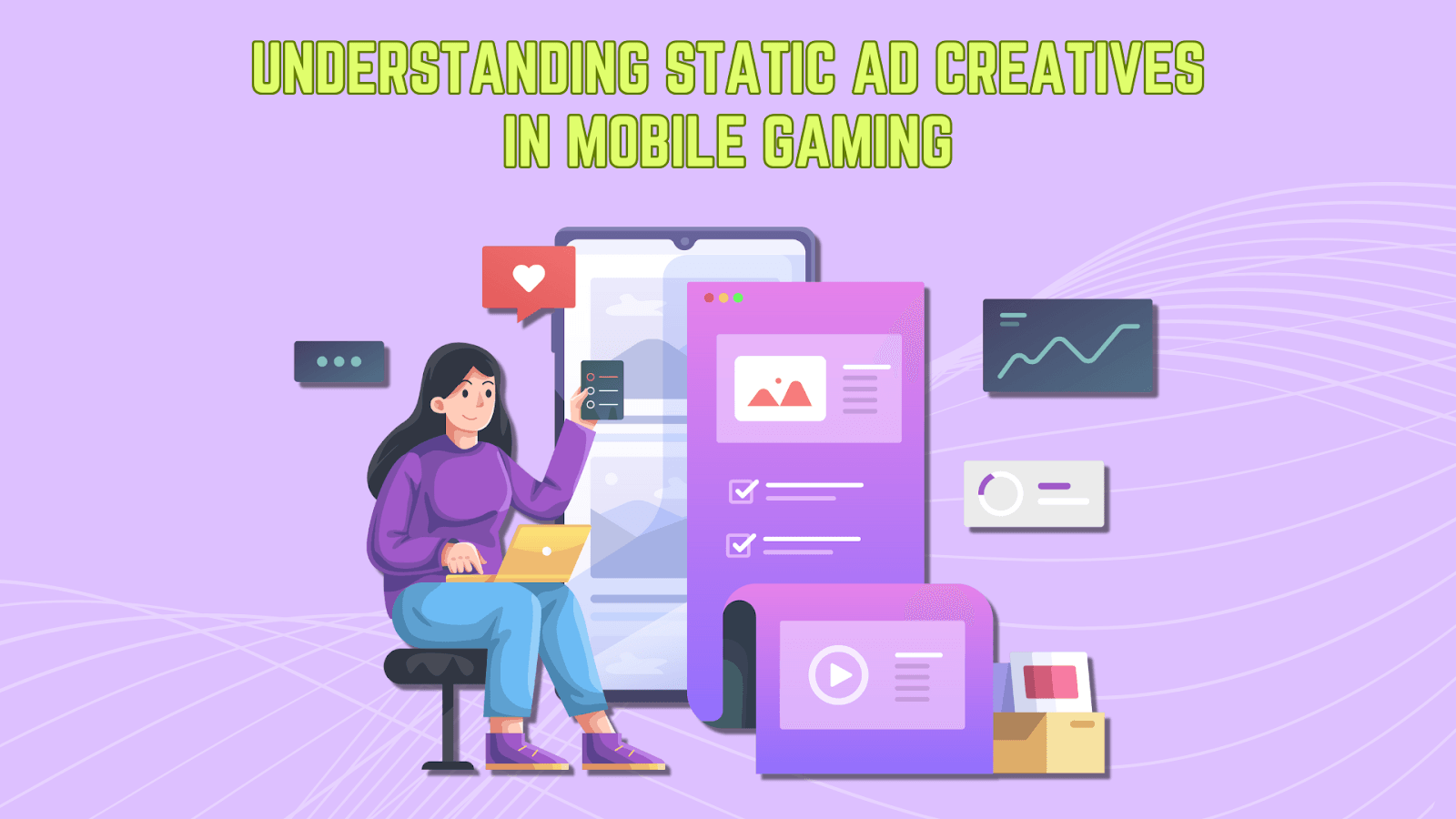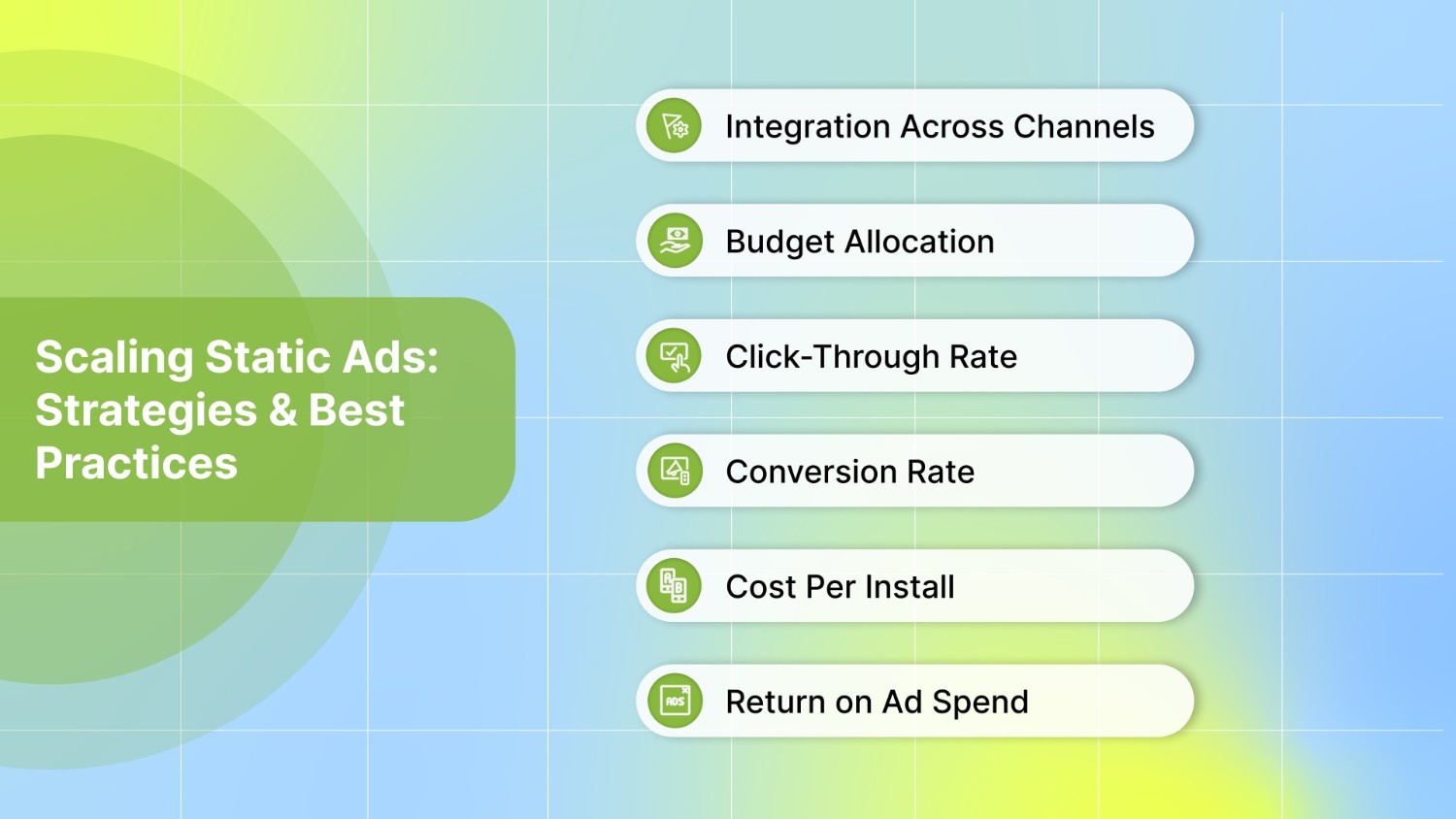Creating and Scaling Static Ads: Strategies and Use Cases
Static ad creatives have long been a cornerstone of mobile gaming user acquisition strategies, offering a cost-effective and efficient means to capture player attention. These ads provide consistent brand visibility and can be seamlessly integrated into gameplay without disrupting the user experience. Their simplicity and clarity make them particularly effective in conveying key messages and driving conversions.
But why are static ad creatives gaining traction in mobile gaming UA? The reason is their reliability and lower production costs. These static ads work well even with a small marketing budget. Unlike complex video ads or interactive formats, static ads are quick to produce and can be easily tailored to fit various marketing channels.
So, how do you effectively utilize static ads in your user acquisition strategy? This blog explores actionable strategies for creating and scaling static ads supported by use cases. Let's start!
Key Takeaways:
Learn how cost-efficiency and ease of production make static ads ideal for budget-sensitive user acquisition campaigns in mobile gaming.
Discover design principles and creative strategies that help static ads capture attention and drive installs effectively.
Understand static ads' limitations, like lower engagement and creative fatigue, and explore tactics to overcome them.
Explore methods for scaling static ads across platforms with consistency in design, strategic budget allocation, and performance tracking.
Understanding Static Ad Creatives in Mobile Gaming

In mobile gaming user acquisition, static ad creatives refer to fixed visual advertisements, such as images or banners, used in marketing campaigns to attract new players. These ads are typically deployed across various channels, including social media platforms, ad networks, and app stores, to drive traffic to a game's download page.
Unlike dynamic or interactive ads, static creatives do not change based on user behavior or other variables. They present consistent messaging and visuals throughout the campaign's duration. While they may lack the engagement levels of video or playable ads, static creatives are cost-effective and can be produced quickly, making them suitable for A/B testing and rapid iteration.
Benefits & Limitations of Static Ad Creatives

Static ads offer simplicity and consistency, making them easy to design and deploy at scale. However, static ads are less adaptable, as they cannot be updated after integration, which leads to decreased relevance over time. Here are some of the benefits and limitations of using these ads in mobile game advertising.
Benefits:
Quick to Produce and Test: Because they’re simpler than video or interactive ads, static creatives can be produced quickly, allowing UA teams to test multiple messages and visuals in a short timeframe.
Cost-Efficient at Scale: For early-stage creative testing, static ads are an affordable way to validate hooks, themes, and characters before investing in high-production assets.
Effective for Retargeting: Static ads often work well for retargeting campaigns, especially when reminding users of previously played games or introducing new features or updates.
Limitations:
Lower Engagement: Static creatives typically see lower click-through and install rates than videos or playables, making them less effective for cold audiences.
Limited Messaging: With just a visual and a short caption, there’s minimal space to explain gameplay or highlight features, which can impact performance for complex games.
Creative Fatigue: Static ads tend to fatigue faster, especially if reused across multiple channels without variation, which can lead to diminishing returns over time.
By understanding these dynamics, user acquisition managers can better decide when and how to incorporate static creatives into their campaigns, especially during initial concept testing or budget-sensitive phases.
Now that we've explored static ads and their benefits and limitations, let’s examine how to design them effectively to capture attention and drive results.
Crafting Effective Static Ads for Your Mobile Game
When crafting static ads for your mobile game, focus on clear, eye-catching visuals and concise messaging highlighting your game's unique features. Use bold call-to-action buttons and relevant visuals to capture the attention of potential players and drive conversions.
Here's how you can create ads that resonate with your audience:
Design Fundamentals:
High-Resolution Visuals: Use clear, high-quality images to showcase your game's most engaging features. High-resolution visuals capture attention and convey professionalism and attention to detail. Whether it’s a dramatic battle, a strategic puzzle move, or a unique character, clarity is key.
Consistent Branding: To strengthen brand recognition, ensure your game's logo, color scheme, and fonts are uniform across all ads. This consistency builds brand trust, improves recall, and makes your game stand out in ad feeds saturated with content.
Eye-Catching Graphics: Incorporate vibrant visuals and dynamic elements to grab attention and spark interest. Using visually appealing designs can make your ads stand out in a crowded market.
Color Palette and Typography: Design with your audience and genre in mind. Bright colors and playful fonts may appeal to casual or arcade gamers, while darker tones and cinematic fonts suit strategy or RPG audiences. Let your typography complement your visual storytelling. For instance, if your game has a fantasy theme, using medieval-style fonts and earthy tones can enhance the thematic feel.
Key Elements to Include:
Clear Call-to-Action (CTA): Use direct phrases like "Play Now" or "Download Today" to guide users on the desired action. A prominent and compelling CTA encourages immediate engagement, increasing the likelihood of conversions.
Resonant Messaging: Craft messages that align with your audience's interests and the unique aspects of your game. Highlight what differentiates your game: “No WiFi Needed,” or “Only 1% Can Beat Level 10.” These micro-messages speak to gamers desires and pain points. Match tone with the game’s mood—fun, intense, or competitive.
Balance Creativity with Simplicity: Keep designs engaging yet straightforward, avoiding clutter to ensure the message is clear. The best-performing static ads often focus on a single in-game moment or value proposition. Keep the visual hierarchy clean: The main visual should come first, followed by the CTA and any supporting message.
Data-Driven Design Decisions:
Utilize Analytics and A/B Testing: Regularly test different ad versions to identify which performs best, refining your approach based on user data. Run creative tests at scale to find your winning concepts. Test variations in characters shown, CTA text, background colors, and even aspect ratios. Analyze metrics like CTR, IPM (installs per mille), and retention to optimize toward quality users, not just volume.
For instance, you might test different ad copy, visuals, or call to action to see which combinations yield higher engagement and conversion rates. This iterative process enables you to make informed decisions that enhance ad effectiveness.
Iterate Based on Performance Data: Regularly analyze the performance of your static ad creatives by examining metrics such as click-through rates (CTR), conversion rates, and cost per install (CPI).
Identify which creative elements, such as visuals, copy, or calls to action, resonate most with your target audience. Use these insights to inform adjustments and optimize future ad iterations, ensuring they align with user preferences and enhance campaign effectiveness.
By focusing on these aspects, you can create static ads that capture attention and drive player engagement and growth for your mobile game.
Once you’ve created compelling static ads, the next step is to scale them effectively to reach a broader audience and maximize performance.
Scaling Static Ads: Strategies and Best Practices

Scaling static ads involves a multifaceted approach that ensures your campaigns reach the right audience effectively and efficiently. Here's how you can enhance your strategy:
Integration Across Channels
Implementing static ad creatives consistently across various platforms is crucial for maintaining brand coherence and maximizing reach. Consider the following steps:
Platform Selection: Identify platforms where your target audience is most active. This includes social media channels like Facebook, Instagram, and gaming ad networks. Each platform has its unique user base and ad formats, so tailor your creatives accordingly.
Ad Placement: Use different placements, such as in-feed posts, stories, banners, and interstitials, to capture user attention without disrupting their experience. For instance, in-game banners can engage users without interrupting gameplay, while social media stories can provide immersive ad experiences.
Consistency: Ensure that your static ads maintain uniformity in design elements—like color schemes, typography, and messaging—across all channels. This consistency reinforces brand recognition and trust. With consistent branding, users can easily identify your game, increasing the likelihood of engagement.
Budget Allocation & Performance Metrics
As you scale your static ad campaigns, it's essential to allocate your budget wisely and monitor key performance indicators (KPIs) to assess effectiveness:
Budget Scaling
Start by allocating a modest budget to test various ad creatives and placements. Once you identify high-performing ads, gradually increase their budget allocation to maximize returns. This approach makes you invest more in ads that resonate with your audience, optimizing your marketing spend.
Key Performance Indicators (KPIs)
Understanding metrics is crucial, but knowing how to leverage them effectively drives success in mobile game user acquisition (UA). Here's how you can utilize key KPIs to optimize your campaigns:
Click-Through Rate (CTR): Enhancing Ad Appeal
CTR measures the percentage of users who click on your ad after seeing it. A high CTR indicates that your ad captures attention. To utilize this:
Test Creative Elements: Experiment with different visuals, copy, and CTAs to identify which combinations resonate best with your audience.
Format Optimization: Experiment with different ad formats (e.g., video, playable, static) to determine which yields the highest CTR.
Monitor Frequency: High CTRs with low conversion rates may suggest ad fatigue; rotate creatives regularly to maintain user interest.
Conversion Rate (CVR): Aligning Expectations with Experience
Conversion rate indicates the percentage of users who install your game after clicking on your ad. A strong CVR means users are compelled to install your game. To utilize this:
Funnel Analysis: Examine the user journey from ad click to installation to identify and address drop-off points.
Landing Page Alignment: Ensure consistency between your ad messaging and the app store page to reduce friction and enhance user trust.
A/B Testing: Conduct A/B tests on different landing pages to determine which elements (e.g., visuals, descriptions) lead to higher conversion rates.
Cost Per Install (CPI): Maximizing Budget Efficiency
CPI measures the cost incurred to acquire a single installation of your game. Managing CPI is essential for cost-effective user acquisition. Here is how you can do this:
Refine Audience Segments: Analyze user demographics and behaviors to target high-value segments, reducing unnecessary spend.
Optimize Bidding Strategies: Adjust bids based on performance data to ensure you're paying the optimal amount per install.
Leverage Retargeting: Implement retargeting strategies to re-engage users who have shown interest but haven't installed your game, encouraging them to complete the installation process.
Return on Ad Spend (ROAS): Measuring Campaign Profitability
ROAS calculates the revenue generated for every dollar spent on advertising. A positive ROAS indicates profitable campaigns:
Focus on High-Value Users: Prioritize acquiring users with higher lifetime value to improve ROAS.
Adjust Campaign Parameters: Tweak targeting, creatives, and bidding strategies to enhance ROAS.
By actively analyzing and adjusting based on these KPIs, you can refine your user acquisition strategies, ensuring optimal resource utilization and improved campaign performance.
Also Read: Analyzing And Measuring Campaign Performance Metrics And Strategies
Automation and Optimization Tools:
Leveraging automation tools can significantly enhance the management and optimization of your static ad campaigns. You can track ad performance with Segwise’s AI-Powered Monitoring & Alerting feature. These tools utilize data from various ad networks and quickly identify underperforming ads, enabling you to make data-driven decisions. With proactive alerts and AI recommendations, you can address issues like creative fatigue or targeting inefficiencies to optimize campaigns and improve return on ad spend.
By integrating these strategies and utilizing appropriate tools, you can effectively scale your static ad campaigns, increasing user acquisition and engagement for your mobile game. Remember, continuous testing and optimization are key to staying ahead in the mobile gaming market.
Now that we’ve covered how to scale static ads effectively, let’s look at how these strategies play out in real-world scenarios.
Case Study: TapNation – Blended In-Game Advertising for Cross-Promotion
TapNation, a mobile game publisher specializing in hyper-casual games, has effectively utilized blended in-game advertising to enhance brand recognition and user acquisition across its game portfolio.
Strategy
TapNation integrates static advertisements within its games, such as in-game billboards, to promote other titles from its portfolio. These ads are seamlessly embedded into the game environment, ensuring they complement the gameplay experience without causing disruption.
Execution
By placing promotional content for their other games within the gaming environment, like virtual billboards, TapNation ensures that players are naturally exposed to their suite of games during regular gameplay. This method leverages the existing user base to introduce and encourage exploration of other titles within the TapNation ecosystem.
Results
This approach has strengthened TapNation's brand identity and increased user engagement across its game offerings. By promoting their games internally, TapNation has seen a boost in installs and user retention, as players are more likely to try out new games from a developer they already enjoy.
Challenges and Considerations
When creating and scaling static ads for your mobile game, it's crucial to address several challenges to ensure your advertising efforts are effective and well-received by your audience.
Ad Fatigue
Overexposing your players to the same ads can lead to ad fatigue, where users become less responsive or entirely indifferent to your advertisements. This decline in engagement reduces the effectiveness of your campaigns and can negatively impact user retention. To combat this:
Rotate Creatives Regularly: Keep your ads fresh by frequently changing visuals, copy, and call to action. This approach prevents monotony and maintains user interest.
Introduce Variety: Develop multiple ad versions highlighting your game's different aspects. By showcasing various features or narratives, you cater to diverse user preferences and keep the content engaging.
Also read: What is Ad Fatigue? Know, Spot, and Fix!
Balancing Ad Frequency and User Experience
Striking the right balance between ad frequency and user experience is crucial. Excessive advertising can overwhelm players, leading to frustration and potential game abandonment. On the other hand, too few ads might result in missed revenue opportunities. To find this balance:
Set Frequency Caps: Limit the number of times an individual user sees the same ad within a specific timeframe. This practice prevents overexposure and reduces the risk of ad fatigue.
Monitor User Feedback: In the critical early stages of user acquisition, it's essential to track how new players respond to static ads. If feedback indicates that players find the ad frequency or placement intrusive, it's important to adjust these elements to enhance the user experience. A smoother, less disruptive ad experience can lead to improved retention rates during the onboarding phase, which is crucial for the long-term success of your game.
By proactively addressing these challenges, you can create a more engaging, respectful, and successful advertising experience for your mobile game's users.
Conclusion
Static ads continue to be a powerful and cost-effective strategy for mobile gaming. These ads offer long-term visibility and seamless integration into gameplay. From understanding their benefits and limitations to crafting visually compelling designs and scaling with performance-driven strategies, static ad creatives can boost user acquisition, maintain brand consistency, and drive sustainable growth.
To take your static ad strategy further, Segwise can let you manage and optimize your ad performance. Its creative agent feature ensures your visuals are continuously tested and analyzed based on user engagement. So, you know exactly what’s working and why.
Ready to elevate your static ad game? Start your 14-day free trial today and unlock smarter, faster ad performance.
Frequently Asked Questions
1. How can static ads help build long-term brand visibility in mobile gaming?
Static creatives consistently reinforce game branding across platforms. When used with uniform design elements like logos, color palettes, and CTAs, they help players instantly recognize your game, building familiarity and trust over time.
2. Are static ads suitable for promoting time-limited events or seasonal content in mobile games?
Yes, static ads can quickly be updated and deployed to highlight in-game events, sales, or seasonal features. Their fast turnaround time makes them ideal for campaigns requiring short lead times and rapid rollouts.
3. How do static ads perform in retargeting campaigns for mobile games?
Static ads are particularly effective in retargeting because they can deliver simple, reminder-style messages that reconnect users with games they’ve played before or prompt action on recent interactions.
4. What creative testing strategies work best with static ads in UA?
Because of their low production cost and fast creation cycle, static ads are perfect for multivariate testing. You can test variables like character visuals, CTAs, and messaging hooks to identify top-performing combinations before scaling.

Comments
Your comment has been submitted successfully!